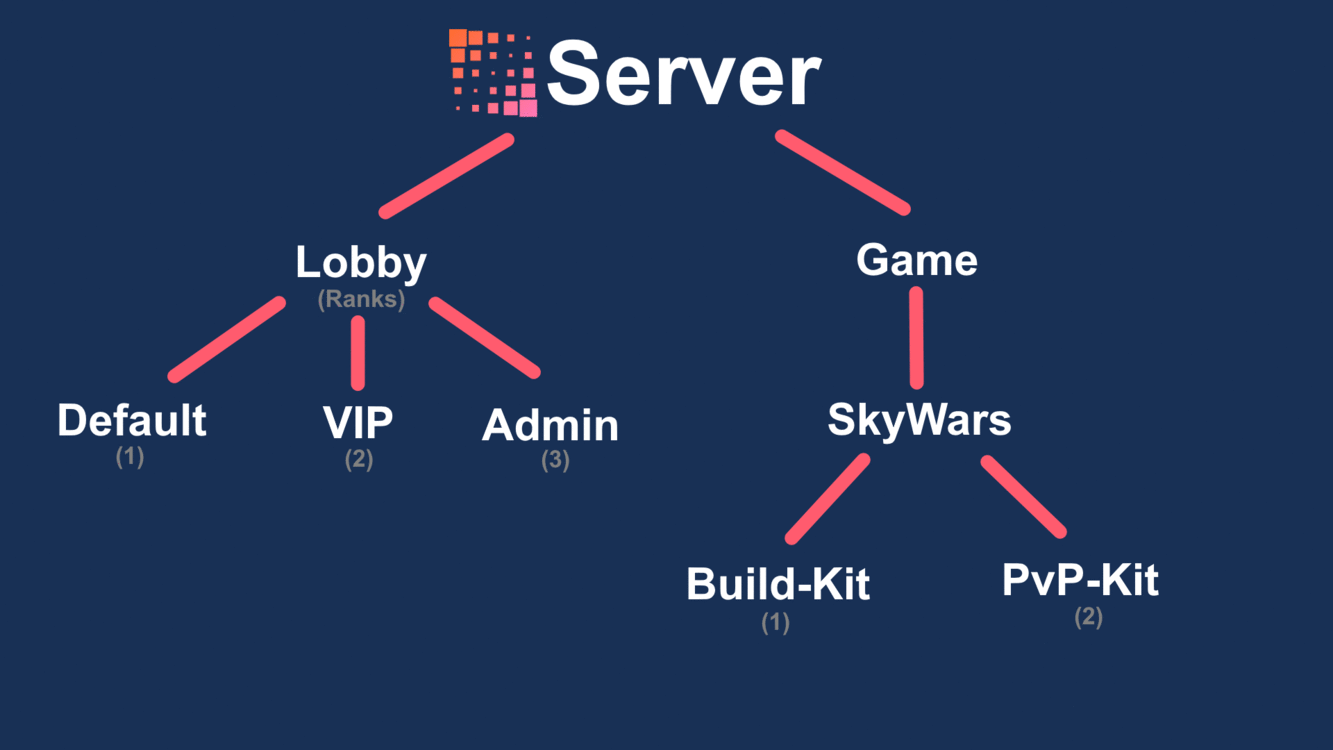Events
Overview
Event listening is a fairly hard part to keep easy while having a clear understanding of the execution flow. In Minestom, a tree is used to define inheritance for filtering and extensibility. Each node of the tree contains:
- Event class, where only subclasses are allowed to enter (
Event/PlayerEvent/etc...) - Condition for filtering
- List of listeners
- Name for identification
- Priority

The tree structure provides us many advantages:
- Context-aware listeners due to node filtering
- Clear execution order
- Ability to store the event tree as an image for documentation purpose
- Listener injection into existing nodes
API
Node
// Can listen to any Event, without any condition
EventNode<Event> node = EventNode.all("demo");
// Can only listen to entity events
EventNode<EntityEvent> entityNode = EventNode.type("entity-listener", EventFilter.ENTITY);
// Can only listen to player events
EventNode<PlayerEvent> playerNode = EventNode.type("player-listener", EventFilter.PLAYER);
// Listen to player events with the player in creative mode
EventNode<PlayerEvent> creativeNode = EventNode.value("creative-listener", EventFilter.PLAYER, player -> player.getGameMode().equals(GameMode.CREATIVE));Each node needs a name to be debuggable and be retrieved later on, an EventFilter containing the event type target and a way to retrieve its actor (i.e. a Player from a PlayerEvent). All factory methods accept a predicate to provide an additional condition for filtering purposes.
Listener
EventNode<Event> node = EventNode.all("demo");
node.addListener(EntityTickEvent.class, event -> {
// Inline listener
});
node.addListener(EventListener.builder(EntityTickEvent.class)
.expireCount(50) // Stop after 50 executions
.expireWhen(event -> event.getEntity().isGlowing()) // Stop once the predicate returns true
.handler(entityTickEvent ->
System.out.println("Entity tick!"))
.build());
EventNode<PlayerEvent> playerNode = EventNode.type("player-listener", EventFilter.PLAYER);
// playerNode.addListener(EntityTickEvent.class, event -> {}); -> does not work as playerNode only accept player events
playerNode.addListener(PlayerTickEvent.class, event -> {});Child
Children take the condition of their parent and are able to append to it.
EventNode<Event> node = EventNode.all("demo");
EventNode<PlayerEvent> playerNode = EventNode.type("player-listener", EventFilter.PLAYER);
node.addChild(playerNode); // Works as PlayerEvent is also an Event
// playerNode.addChild(node); -> Doesn't compile as the parent would be more restrictive than the childEvent execution
Events can be executed from anywhere, not only the root node.
EventNode<Event> node = EventNode.all("demo");
node.call(new MyEvent());In practice
Now that you are familiar with the API, here is how you should use it inside your Minestom project.
Node to use
Server JAR
The root node of the server can be retrieved using MinecraftServer#getGlobalEventHandler(), you can safely insert new nodes.
var handler = MinecraftServer.getGlobalEventHandler();
handler.addListener(PlayerChatEvent.class,
event -> event.getPlayer().sendMessage("You sent a message!"));
var node = EventNode.all("demo");
node.addListener(PlayerMoveEvent.class,
event -> event.getPlayer().sendMessage("You moved!"));
handler.addChild(node);Structure
Having an image of your tree is highly recommended, for documentation purposes and ensuring an optimal filtering path. It is then possible to use packages for major nodes, and classes for minor filtering.
Server/
Global.java
Lobby/
Rank/
- AdminRank.java
- VipRank.java
- DefaultRank.java
Game/
Bedwars/
Kit/
PvpKit.java
BuildKit.java
Bedwars.java
Skywars/
Kit/
PvpKit.java
BuildKit.java
Skywars.javaCustom event
Event is an interface that you can freely implement, traits like CancellableEvent (to stop the execution after a certain point) and EntityEvent (telling the dispatcher that the event contains an entity actor) are also present to ensure your code will work with existing logic. You can then choose to run your custom event from an arbitrary node (see example), or from the root with EventDispatcher#call(Event).
